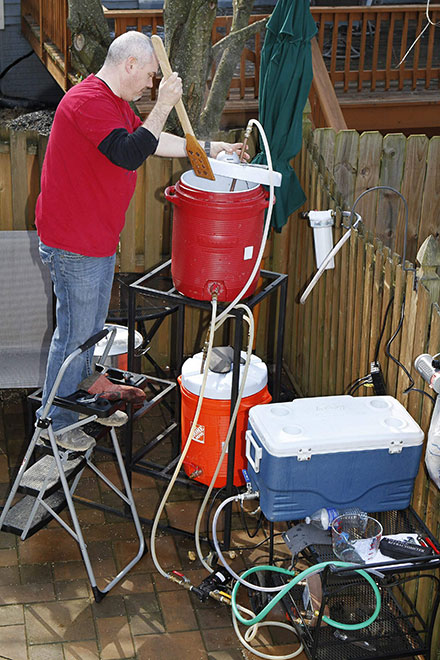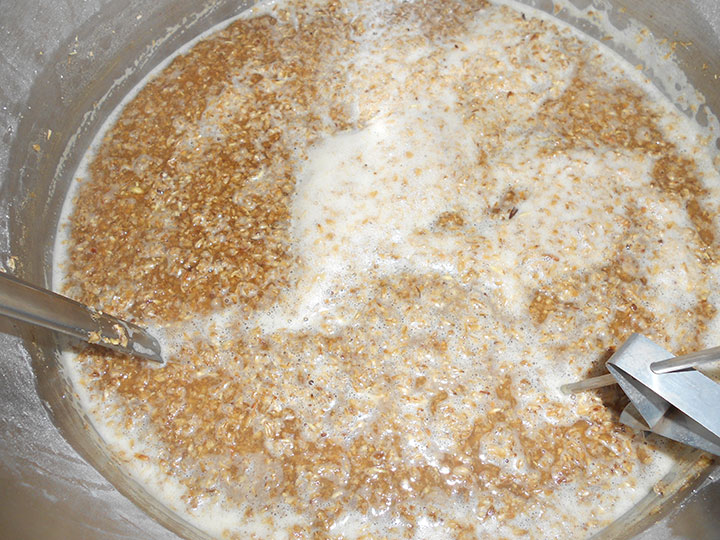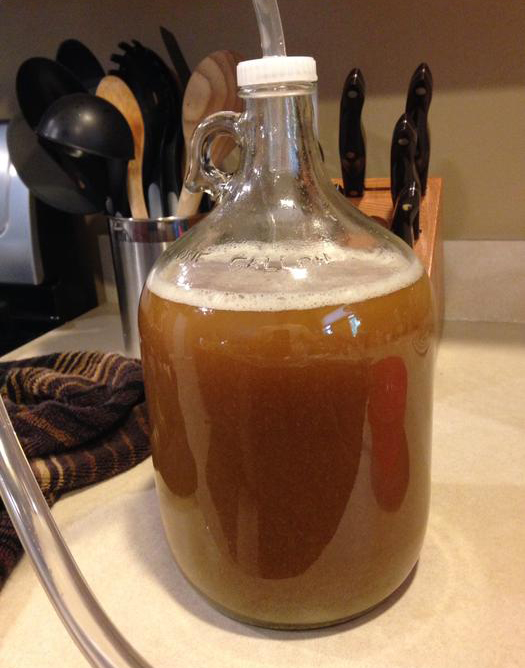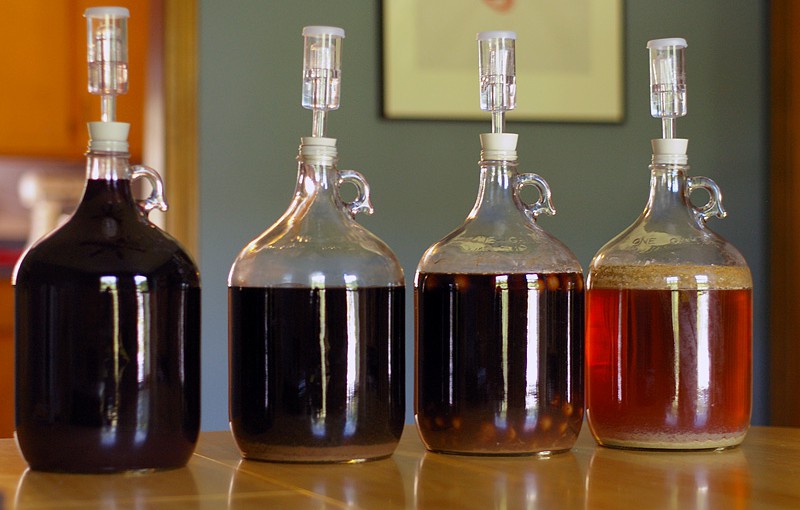Advantages of brewing 1 gallon / 5 liters at a time
It can be done in a typical urban kitchen, with cookware most people already have
Kits are less bulky
You can try different recipes as often as every two weeks without ending up with tons of beers
It takes less grain, so it’s cheaper and you can use expensive ingredients such as honey or maple syrup
You end up with about 10 bottles per batch, which doesn’t take much space, is easy to drink until next time and not a big deal if you don’t like the taste of your beer
Fermenters are light and easy to handle, a major advantage to get into homebrewing without moving a 50lb (25 kg) tank around
You typically have 4 or 5 different beers to enjoy at the same time instead of 60 bottles of the same beer
What is so revolutionary about brewing a gallon at a time rather than 5 gallons like homebrewers have been doing for decades?

Gallon kits are tailored for urban enthusiasts who live in apartments that could hardly host a full-sized kit
You don’t want to lift a 50lb (25 kg) container loaded with beer and have to store it the rest of the time along with 50 bottles
Typical 5-gallon kits are complicated and ugly, most of the time based on malt extract (at least for the first batch), they dumb down the fun steps too much and focus on unnecessary ones that have limited consequences on the taste of your beer, disappoint brewers by often ending up with 5 gallons of undrinkable beer and don’t incite a cooking-like improvisation-based approach of brewing
For all these reasons, gallon brewing is a genuine revolution that opens craft beer making to many people, including a more urban population, by making it more fun, less heavy, better looking and more manageable
What is so cool about all-grain beer brewing?

As opposed to traditional starter kits, which mostly consist in diluting malt extract in boiling water, gallon brewing kits allow to jump straight to all-grain brewing, which is the utmost brewing method, the same used in professional breweries, and takes brewers through all the steps of extracting sugars from actual barley grain themselves
After a first batch, following a recipe to the letter, you will have figured out the basic principles of all-grain beer brewing and want to start improvising your own recipes. More about this here Create small batch beer recipes
Thanks to small batches, beer brewing resembles more to cooking, with all the improvisation and personal touch that cooking allows
What’s wrong with malt extract kits?

If you ever tried a traditional brewing kit based on malt extract (which comes in cans and looks like caramel), you very likely ended up with a kind of soft drink with a remote taste of beer and huge Coke-like bubbles
This is because malt extract kits come with poor instructions, old yeasts (if not dead) and bottling instructions that cause oxygenation
Most of all, malt extract kits start very late in the brewing process, all you have to do is basically to dilute malt extract and bottle the beer, you don’t go through the most interesting and creative steps of extracting sugars from actual grain yourself
On top of taking huge space and being hard to handle, 5-gallon kits often leave the brewer with 50 bottles of undrinkable beer and a very bulky tank you don’t know where to store
Finally, you can’t try new recipes so often
Why a glass fermenter?

Glass fermenters have all possible advantages:
They don’t release any chemicals into your beer
They don’t host bacterias in microcracks
They are transparent, so you can observe (and learn) everything that’s going on in your beer during fermentation
Can you make good beer?

Sure!
You can make beer that both tastes better and has more body than many commercial beers as you have total control on the ingredients you put in your beer and can use some that are too expensive for commercial production, typically honey and maple syrup
You control the quality of everything you put in your beer and can make it fully organic for example. More info on How to brew organic beer
There’s no limit to creativity as all-grain brewing starts from the very first steps of brewing and allows to include any ingredient to your batch such as lime peel or non-fermentable sugars
All-grain brewing allows to create beer with a foam head that holds for long (head retention) thanks to the better control on all stages of the brewing process
Is it difficult?
Not at all
The beauty of this new approach, based on small all-grain batches, is that it basically gets rid of all the unnecessary/complicated steps like adjusting water pH, mash steps, rehydrating yeast and so on, while focusing on the most fun ones that give more control on the final taste of your beer by starting a few steps earlier in the brewing process
Beer brewing has never been so easy and interesting and it’s now all-grain!
How much does it cost?
A kit costs $40 and that’s all you will need
It comes with all the ingredients for your first brew: malt, hops, yeast, sanitizer
For further batches, you will either keep relying on ready mixes (not fun) or compose your own recipes (super easy) and gather the ingredients yourself (fun, about 10 bucks)
We have detailed information on How to create beer recipes
Beer brewing is basically a poor man’s hobby and expenses never go through the roof, except if you start getting some semi-pro equipment for larger batches
Most of all, it’s such a consuming passion that any cost factor will quickly disappear from your mind and all you will care about will be to get the best possible stuff
Why should you read this website?
It provides solutions to many details still unclear in instructions coming with 1 gallon brew kits such as the Brooklyn Brew Kit, as well as additional hints learnt by a total newbie through experience and reads
It’s the only resource solely dedicated to small batch beer brewing
It also provides information to Europeans who want to get into gallon/small batch brewing without access to all-inclusive kits
We have infos on How to build the kit yourself
Brewer
Latest posts by Brewer (see all)
- 1-gallon Plastic Beer Fermenter - 03/10/2017
- Create beer bottle labels - 26/01/2016
- Grow your own hops - 30/03/2015

Where or how did you make the cover for your jar that connects to the blow off tube? It looks really nice.
Hi Sam,
The cap comes with the Brooklyn Brew Kit
It fits both the blow off tube and airlock
Otherwise, you can get it from Amazon, but my advice is that you go for a rubber stopper instead, which is more airtight
Thanks for the reply. Just did my fist batch last night and everything’s looking good. One slight issue I came across was when it came time to put the rubber stopper on it kept sliding out (prob because it was soapy/wet from sanitation) so I taped it down to the bottle. Crossing fingers haha
Hi,
We’ve been in contact before and you’ve given some great advice. I just thought I’d pick up on Sam’s point about the rubber bung.
I’ve found the same in my 5 litre carboy with a rubber bung. It slides out. The advice I’ve read on forums is to dry the bung and the inside of the carboy neck with paper towel. However, people showed concern about contamination. Obviously it is more of a risk but I am taking it must be a small one. What are your thoughts? Can’t keep the neck totally dry as you need to shake up the beer when adding your yeast.
I didn’t have this problem with my first kit as it is the BBS kit with the screwtop (which I prefer).
As ever, any advice much appreciated.
Cheers,
Craig – Manchester, UK
ps – I dried it out with paper towels last night for my Rye IPA brew (Har-Rye-Kane), so will soon see whether this has any adverse effects on the beer.
The other time I just jammed the bung in but it got stuck and had to prize out with pliers 🙂
Thanks for a very informative website/blog. A lot to read. I started with the Mr Beer kit for just a few batches. (I hate plastic) Then I moved to 1 gallon brewing. Not because of space, but because I love beer but don’t drink that much. I want to brew and 8-10 bottles is plenty for me. Plus right now I have 2 batches fermenting and 1 carbonating. So I get the variety but not the quantity. These 3 batches came from Northern Brewing along with my kit, but I will be going to my LHBS for all the rest that I do. And you can never have enough knowledge about this hobby. So I will continue to read here and anywhere else I can get good info.
Hi Dave,
Thanks for the friendly comment.
Funnily enough, I followed more or less the same path: after a few batches with the Brooklyn Brew Kit, I started brewing larger batches (5 Gal. / 20L) with semi-pro equipment (Braumeister).
The beer turned out amazing, but I didn’t know what to do with 60 bottles of the same beer, even though I was giving away as many as I could. Drinking the same beer all the time was boring.
I’m now back to small batches and try to constantly have 5 different beers in my fridge, which is much more fun.
Brewing with better equipment also made me improve my typical BBK brewing procedure and I’m now able to brew basically the same quality as with the Braumeister.
Most of all, you have to sparge well, use a wort chiller and I now use a conical fermenter (FastFerment), which allows to reduce the contact surface between the trub and the beer, do a primary and a secondary fermentation without racking and bottle with minimal oxidation.
I was also against plastic, but the FastFerment is in plastic and I never had to complain about it.
Thanks for this site! It’s gratifying to find I’m not the only one who finds small batches make a lot more sense. You mentioned in a recent reply that you use the FastFerment conical fermenter. The only one I can find is a 7.9 gallon version, which kind of kills the space-saving aspect. BrewDemon makes a smaller one, but without a yeast dump, so I’m not thrilled with shelling out for it. Do you use the large FastFerment, or can you direct me to a small one? Thanks for your time!
Hi Ethan,
I also looked for a smaller conical fermenter, but unfortunately, I don’t think that exists.
The BrewDemon is actually pretty cool and the tap is placed high enough to let you bottle without sucking the trub.
I think that would be a good option. It’s a bit pricey, though.
Other than that, small batches don’t take too much time to rack and bottle, so, a conical fermenter is less necessary.
Just ordered my first BBK, looking forward to my first small batch. This blog will definitely help in making in a success. Thanks for all of the useful information! Do the pots used have to be stainless steel?
Actually, the more you brew, the more you will become relax with this kind of details. Stainless steel is the best, but aluminum works just as well. Just make sure you don’t burn the grain at the bottom and you are good to go.
True. You can make great beer both all-grain and with extract. This said, all-grain is more fun, more real and gives you more flexibility. At the end of the day, it just depends on a personal preference.
I messed up. Was having difficulty getting he wort to the boil and ended up leaving the lid partially on while gently boiling for an hour. How big of a mistake was that? I will bottle next weekend. Happy I got the first try done. Few things I will do differently next time.
Hi Chris,
Having partially left the lid during the boil is definitely not a big deal, but if you didn’t reach a boil for most of the hour, that might indeed significantly affect the quality of you beer.
Bottle it, wait for enough time (at least 3 weeks, if not more) and see.
We learn from our mistakes, you’ll do better next time.
Hi Brewer,
I’ve been brewing 5 gallon all grain batches for a few years and almost always love the end product. I’m not going to give up on the 5 gallon batches but I’m also pretty excited to take the plunge at start going with some one gallon batches. I just love the idea of experimenting more often as well as the fact that starting a 5 gallon batch after putting kids to bed takes a lot of ambition.
A couple of questions:
1. Assuming the 1 gallon growler is the secondary, what do you use for a primary? Or do you just do a single stage fermentation?
2. How much yeast do you pitch? I’m assuming a full pack of dry is overkill. Same thing with liquid yeast, plus the fact that they’re typically $10 a pack where I shop.
Thanks!
Hi there!
Thanks for asking
1. You can go ahead with a single stage fermentation, this will significantly reduce the risk of contamination and it won’t make any noticeable difference on the taste of the finished beer
2. I pitch a quarter pack (= 3g)
I use this high precision scale for this, which is also great for hops additions
When you are done, you can roll the top of the pack a couple of times, seal it with tape and store in the fridge, no problem to use yeast several times this way, even if batches are months apart
By the way, US-05 (American Ale) gives great results with most ales and it’s generally cheaper than liquid activators
This won’t make any noticeable difference either
After brewing 5 gal. Batches for 20 years, I finally got smart and went to gallon batches for all the reasons stated. Nearly all of my recipes can be divided by 5, except for two things, water and yeast. Water will take some trial and error. Depending on how much water the grain absorbs and your rate of boil off. When all is said and done, I average 1.5 to 1.75 gallons of wort just prior to boil. Some having been lost to evaporation and some left behind in the precipitate in the primary and secondary. For yeast, approximately 40% of the packet seems fine.
I noticed a significant improvement in my beers as soon as I started brewing one-gallon batches.
Thank you so much for your website, great explanation of the whole process, I based my first batch on your step by step “How to” now let’s see what will happen…
Great information. Thanks for creating this website.
Good work i would like to know if anyone here make a non-alcoholic
Yes, you can, with most beers, and it’s actually quite simple.
All you have to do is to put your beer in a kettle in the oven at around 175F (80°C) for 15-20 minutes to let the alcohol evaporate.
Thank you for this website!! I’m starting my first brew tomorrow and I’ve done a lot of research, and this by far has been my most useful resource. So much good stuff. Happy brewing!!
Hello mate!
Nice website. Thanks for that. I really appreciate all the information you give here, as a person who started with 30 liter batches and turned back to a gallon and found it much more useful.